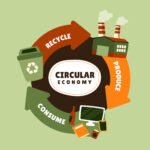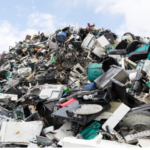
Navigating the E-Waste Challenge: Strategies for Responsible Management

In our ever-evolving digital world, electronic devices have become ubiquitous, powering our daily lives and driving innovation. However, with this technological revolution comes a significant challenge: electronic waste, or e-waste. As the pace of technological advancement accelerates, the need for sustainable e-waste management has never been more critical. In this blog, we’ll explore the impact of e-waste, the importance of responsible management, and strategies for tackling this growing environmental issue.
Understanding E-Waste: The Scope of the Problem
E-waste encompasses a wide range of discarded electronic devices, including smartphones, computers, televisions, and household appliances. According to the Global E-Waste Monitor, approximately 53.6 million metric tones of e-waste were generated worldwide in 2019, with only a fraction being properly recycled or disposed of. This staggering amount of waste poses significant environmental and health risks, as e-waste often contains hazardous materials such as lead, mercury, and cadmium.
The Environmental Impact of E-Waste
Improper disposal of e-waste can have devastating consequences for the environment. When electronic devices end up in landfills, toxic substances can leach into the soil and water, contaminating ecosystems and posing risks to human health. Additionally, the extraction and processing of raw materials for electronic devices contribute to deforestation, habitat destruction, and greenhouse gas emissions, further exacerbating environmental degradation and climate change.
The Importance of Responsible Management
Effective e-waste management is essential for mitigating these environmental and health risks. By implementing responsible disposal practices, we can minimize the negative impact of e-waste on our planet and create a more sustainable future. Responsible management involves:
- Recycling: Recycling e-waste allows valuable materials to be recovered and reused, reducing the need for new raw materials and conserving natural resources. Through recycling, we can also prevent hazardous substances from entering the environment and minimize energy consumption associated with the production of new electronic devices.
- Reuse and Repurposing: Extending the lifespan of electronic devices through reuse and repurposing can significantly reduce e-waste generation. Encouraging consumers to repair, refurbish, or donate their old devices can help minimize the environmental footprint of electronic products and promote a circular economy.
- Regulatory Compliance: Governments and regulatory bodies play a crucial role in addressing the e-waste challenge through legislation and enforcement of recycling and disposal standards. By implementing comprehensive e-waste management policies and regulations, we can ensure proper handling of electronic waste and hold producers accountable for their products’ end-of-life management.
Strategies for Effective E-Waste Management
To address the e-waste challenge effectively, businesses, governments, and consumers must work together to implement sustainable solutions. Some strategies for promoting responsible e-waste management include:
- Education and Awareness: Increasing public awareness about the environmental and health impacts of e-waste is essential for driving behavior change and promoting responsible disposal practices. Educational campaigns, workshops, and community outreach initiatives can help inform consumers about the importance of recycling and proper e-waste disposal.
- Collaboration and Partnerships: Collaboration between governments, businesses, NGOs, and the recycling industry is critical for developing innovative solutions and infrastructure for e-waste management. By working together, stakeholders can leverage their expertise and resources to improve collection, recycling, and disposal processes.
- Product Design and Innovation: Designing electronic products with end-of-life considerations in mind can facilitate easier disassembly, repair, and recycling. Manufacturers can also explore alternative materials and technologies to reduce the environmental impact of electronic devices and promote sustainability throughout the product lifecycle.
Conclusion: Towards a Sustainable Future
In conclusion, e-waste management is a complex and pressing environmental issue that requires collective action and commitment from all stakeholders. By adopting responsible disposal practices, promoting recycling and reuse, and implementing regulatory measures, we can mitigate the negative impact of e-waste on our planet and create a more sustainable future for generations to come. Together, let’s navigate the e-waste challenge and pave the way for a cleaner, greener world.





